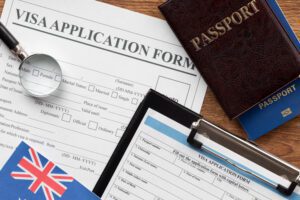What Is A Bridging Visa?
A bridging visa is a temporary visa that the Department of Home Affairs (DHA) might grant in certain circumstances to allow a non-Australian citizen to remain in Australia for a certain period of time.
Bridging visas can be granted before or after a substantive visa ceases to be in effect. These visas are subject to each person’s individual immigration status.
Here you can find everything you need to know about the types of bridging visas.
The Different Types Of Bridging Visas In Australia
Bridging Visa A (BVA)
A Bridging Visa A (BVA) is granted in association with an application for a substitute visa that can be granted in Australia and the person made the application onshore. It allows people to stay in Australia lawfully after their current substantive visa ceases and while their substantive visa application is being processed or finally determine.
In some circumstances, a BVA would have the same conditions attached to it as the visa held at the time of application. Some BVA may or may not have work rights, this is an important factor that should be part of the person’s visa strategy.
However, if it does not come with work rights, or has restrictions on working, people can apply for another BVA that lets them work. Applicants would typically need to demonstrate financial hardship for work rights to be granted in this situation.
This type of bridging visa also allows people to apply for permission to travel overseas for a limited period of time, but they will need to be in Australia when a decision on their application is made.
Bridging Visa B (BVB)
A Bridging visa B (BVB) is a temporary visa that allows people to leave and return to Australia while their application for a substantive visa is being processed. So, for example, when a BVA holder would like to travel overseas, they have to apply for a BVB.
A BVB allows the visa holder to depart and return to Australia during a specified travel period while their application for a substantive visa is processed. If they depart Australia with another type of bridging visa in effect, then that visa will cease, and they may not be able to re-enter Australia until the Department grants them the substantive visa that is being processed.
Bridging Visa C (BVC)
Similar to the BVA, a Bridging Visa C (BVC) is a temporary visa that is granted when someone has made a valid application in Australia for a substantive visa, however, they do not already hold a substantive visa. This means that the person lodged an application while holding a bridging visa or was unlawfully in Australia after their substantive visa has expired.
A holder of a BVC cannot travel outside of Australia and return and generally, this visa comes without work rights. But if a person is granted this visa with a condition that prohibits them from working, they may apply for a new Bridging Visa C without the work prohibition attached to it, if eligible.
Bridging Visa E (BVE)
A Bridging Visa E (BVE) lets people stay lawfully in Australia while they make arrangements to leave the country, finalise their immigration matter or wait for an immigration decision.
BVE are granted as a way to remain in Australia while people make an application for a substantive visa, wait for a decision by a court on an appeal, or wait for Ministerial Intervention to grant them a visa. They are also granted when a person has applied for a protection visa.
A Bridging Visa E comes with very strict conditions. They usually have reporting conditions, requiring the holder to report to a Department of Home Affairs’ office periodically. The visa also usually comes with no work and no study conditions. Permission to work may be requested by the Department.
Bridging Visa D (BVD), Bridging Visa R (BVR), and Bridging Visa F (BVF)
A Bridging Visa D (BVD) is granted when someone tried but was unable to apply for a substantive visa. For example, they did not pay the correct charge or filled out the wrong visa application form or an authorised officer is not available to interview them, but they will be able to do so within the next five working days.
A Bridging Visa R (BVR) is for people who are in immigration detention but their removal from Australia is not reasonably practicable. This allows them to be released from detention pending their removal.
A Bridging Visa F (BVF) is used exclusively for suspected victims of trafficking or slavery who do not hold a substantive visa.
How To Apply For A Bridging Visa In Australia?
For further information regarding a bridging visa application in Australia, contact Absolute Immigration to arrange an online consultation with one of our qualified migration agents.







